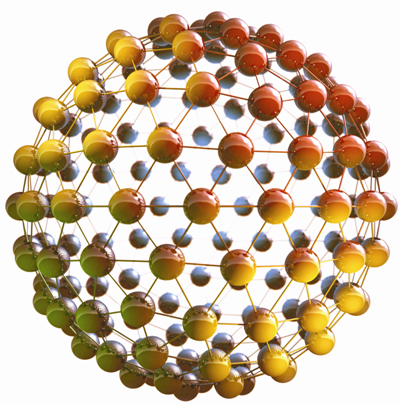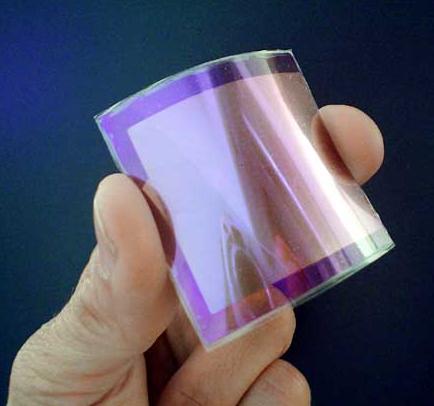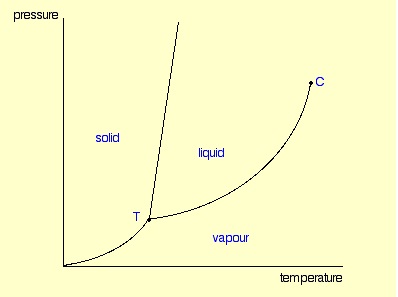What is Nanocomposite ?
A nanocomposite is as a multiphase solid material where one of the phases has one, two or three dimensions of less than 100 nanometers (nm), or structures having nano-scale repeat distances between the different phases that make up the material. The mechanical, electrical, thermal, optical, electrochemical, catalytic properties of the nanocomposite will differ markedly from that of the component materials. Size limits for these effects have been proposed, <5 nm for catalytic activity, <20 nm for making a hard magnetic material soft, <50 nm for refractive index changes, and <100 nm for achieving superparamagnetism, mechanical strengthening or restricting matrix dislocation movement.
The definition of nano-composite material has broadened significantly to encompass a large variety of systems such as one-dimensional, two-dimensional, three-dimensional and amorphous materials, made of distinctly dissimilar components and mixed at the nanometer scale.
The general class of nanocomposite organic/inorganic materials is a fast growing area of research. Significant effort is focused on the ability to obtain control of the nanoscale structures via innovative synthetic approaches. The properties of nano-composite materials depend not only on the properties of their individual parents but also on their morphology and interfacial characteristics. This rapidly expanding field is generating many exciting new materials with novel properties. The latter can derive by combining properties from the parent constituents into a single material. There is also the possibility of new properties which are unknown in the parent constituent materials.
Nanocomposite coatings in air conditioner elements could provide an energy-efficient way of clearing ozone from outside air before it enters the cabin in planes such as the Airbus A380
The inorganic components can be three-dimensional framework systems such as zeolites, two-dimensional layered materials such as clays, metal oxides, metal phosphates, chalcogenides, and even one-dimensional and zero-dimensional materials such as (Mo3Se3-)n chains and clusters. The general class of organic/inorganic nanocomposites may also be of relevance to issues of bio-ceramics and biomineralization in which in-situ growth and polymerization of biopolymer and inorganic matrix is occurring. Finally, lamellar nanocomposites represent an extreme case of a composite in which interface interactions between the two phases are maximized. Since the remarkable properties of conventional composites are mainly due to interface interactions, the materials dealt with here could provide good model systems in which such interactions can be studied in detail using conventional bulk sample (as opposed to surface) techniques. By judiciously engineering the polymer-host interactions, nanocomposites may be produced with a broad range of properties.
In mechanical terms, nanocomposites differ from conventional composite materials due to the exceptionally high surface to volume ratio of the reinforcing phase and/or its exceptionally high aspect ratio. The reinforcing material can be made up of particles (e.g. minerals), sheets (e.g. exfoliated clay stacks) or fibres (e.g. carbon nanotubes or electrospun fibres). The area of the interface between the matrix and reinforcement phase(s) is typically an order of magnitude greater than for conventional composite materials. The matrix material properties are significantly affected in the vicinity of the reinforcement. Ajayan et al. note that with polymer nanocomposites, properties related to local chemistry, degree of thermoset cure, polymer chain mobility, polymer chain conformation, degree of polymer chain ordering or crystallinity can all vary significantly and continuously from the interface with the reinforcement into the bulk of the matrix.
For example, adding carbon nanotubes improves the electrical and thermal conductivity. Other kinds of nanoparticulates may result in enhanced optical properties, dielectric properties, heat resistance or mechanical properties such as stiffness, strength and resistance to wear and damage. In general, the nano reinforcement is dispersed into the matrix during processing. The percentage by weight (called mass fraction) of the nanoparticulates introduced can remain very low (on the order of 0.5% to 5%) due to the low filler percolation threshold, especially for the most commonly used non-spherical, high aspect ratio fillers (e.g. nanometer-thin platelets, such as clays, or nanometer-diameter cylinders, such as carbon nanotubes).
You might also like
| Nanomaterials - the Future Technology Nanomaterials - Applications for Nanotechnology Nanomaterials... | Nanotechnology Solar Cells Nanotechnology Solar Panels - Using Nanotechnology... | Advanced Energy Materials : Supercapacitors ! What is Supercapacitor ? The supercapacitor,... | The Basic Phase Diagram What is a Phase Diagram ? A phase diagram... |




 Alloy Suppliers
Alloy Suppliers
 Aluminum
Aluminum
 Aluminum Extrusions
Aluminum Extrusions
 Copper-Brass-Bronze
Copper-Brass-Bronze
 Nickel
Nickel
 Magnets
Magnets
 Stainless Steel
Stainless Steel
 Stainless Steel Tubing
Stainless Steel Tubing
 Steel Service Centers
Steel Service Centers
 Titanium
Titanium
 Tungsten
Tungsten
 Wire Rope
Wire Rope